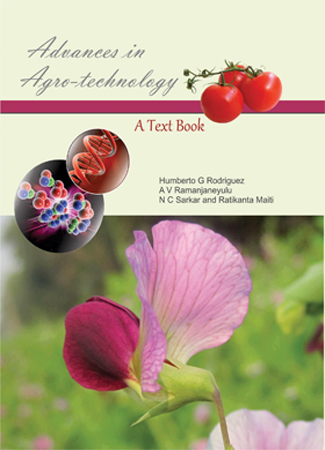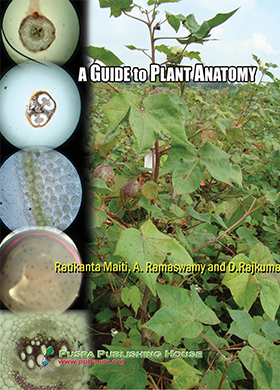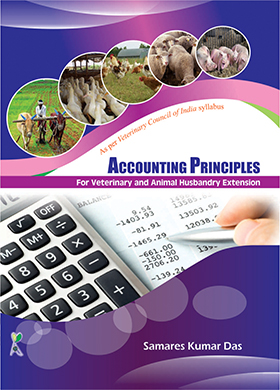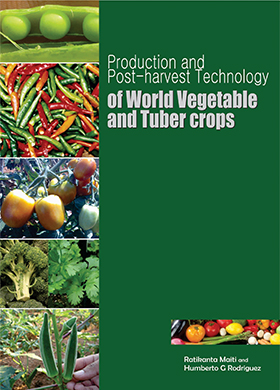Table 1: Tomato genotypes used in the study
Table 2: Digital features employed for assessing response of tomato genotypes to water stress
Figure 1: Differences in digital biomass percentage reduction among nine tomato genotypes under deficit water stress. Values are the means±SEM (n=4)
Figure 2: Differences in digital biomass percentage recovery among nine tomato genotypes under deficit water stress.Values are the means±SEM (n=4)
Figure 3: Top view area of tomato genotypes under stress and recovery conditions. Values are the means±SEM (n=4)
Plate 1: Top view images of tomato genotype IIHR 2843 depicting digital features under control, stress and recovery conditions
Figure 4: Relationship between convex hull area and water lost in tomato under deficit water stress
Figure 5: Relationship between leaf area and compactness in tomato under deficit water stress
Table 3: The variations in relative water content, water potential andquantum efficiency of PSII in nine tomato genotypes under two water regimes
Table 4: The differences in total osmolyte and MDA contents in nine tomato genotypes under two water regimes
Table 5: Relationship between digital biomass and other digital features under control, stress and recovery conditions
Figure 6: Digital biomass of IIHR 2195 and IIHR 2843 at 100% and 50% FC. Values are the means±SEM (n=3)
Table 1: Tomato genotypes used in the study
Table 2: Digital features employed for assessing response of tomato genotypes to water stress
Figure 1: Differences in digital biomass percentage reduction among nine tomato genotypes under deficit water stress. Values are the means±SEM (n=4)
Figure 2: Differences in digital biomass percentage recovery among nine tomato genotypes under deficit water stress.Values are the means±SEM (n=4)
Figure 3: Top view area of tomato genotypes under stress and recovery conditions. Values are the means±SEM (n=4)
Plate 1: Top view images of tomato genotype IIHR 2843 depicting digital features under control, stress and recovery conditions
Figure 4: Relationship between convex hull area and water lost in tomato under deficit water stress
Figure 5: Relationship between leaf area and compactness in tomato under deficit water stress
Table 3: The variations in relative water content, water potential andquantum efficiency of PSII in nine tomato genotypes under two water regimes
Table 4: The differences in total osmolyte and MDA contents in nine tomato genotypes under two water regimes
Table 5: Relationship between digital biomass and other digital features under control, stress and recovery conditions
Figure 6: Digital biomass of IIHR 2195 and IIHR 2843 at 100% and 50% FC. Values are the means±SEM (n=3)
Table 1: Tomato genotypes used in the study
Table 2: Digital features employed for assessing response of tomato genotypes to water stress
Figure 1: Differences in digital biomass percentage reduction among nine tomato genotypes under deficit water stress. Values are the means±SEM (n=4)
Figure 2: Differences in digital biomass percentage recovery among nine tomato genotypes under deficit water stress.Values are the means±SEM (n=4)
Figure 3: Top view area of tomato genotypes under stress and recovery conditions. Values are the means±SEM (n=4)
Plate 1: Top view images of tomato genotype IIHR 2843 depicting digital features under control, stress and recovery conditions
Figure 4: Relationship between convex hull area and water lost in tomato under deficit water stress
Figure 5: Relationship between leaf area and compactness in tomato under deficit water stress
Table 3: The variations in relative water content, water potential andquantum efficiency of PSII in nine tomato genotypes under two water regimes
Table 4: The differences in total osmolyte and MDA contents in nine tomato genotypes under two water regimes
Table 5: Relationship between digital biomass and other digital features under control, stress and recovery conditions
Figure 6: Digital biomass of IIHR 2195 and IIHR 2843 at 100% and 50% FC. Values are the means±SEM (n=3)
Table 1: Tomato genotypes used in the study
Table 2: Digital features employed for assessing response of tomato genotypes to water stress
Figure 1: Differences in digital biomass percentage reduction among nine tomato genotypes under deficit water stress. Values are the means±SEM (n=4)
Figure 2: Differences in digital biomass percentage recovery among nine tomato genotypes under deficit water stress.Values are the means±SEM (n=4)
Figure 3: Top view area of tomato genotypes under stress and recovery conditions. Values are the means±SEM (n=4)
Plate 1: Top view images of tomato genotype IIHR 2843 depicting digital features under control, stress and recovery conditions
Figure 4: Relationship between convex hull area and water lost in tomato under deficit water stress
Figure 5: Relationship between leaf area and compactness in tomato under deficit water stress
Table 3: The variations in relative water content, water potential andquantum efficiency of PSII in nine tomato genotypes under two water regimes
Table 4: The differences in total osmolyte and MDA contents in nine tomato genotypes under two water regimes
Table 5: Relationship between digital biomass and other digital features under control, stress and recovery conditions
Figure 6: Digital biomass of IIHR 2195 and IIHR 2843 at 100% and 50% FC. Values are the means±SEM (n=3)
Table 1: Tomato genotypes used in the study
Table 2: Digital features employed for assessing response of tomato genotypes to water stress
Figure 1: Differences in digital biomass percentage reduction among nine tomato genotypes under deficit water stress. Values are the means±SEM (n=4)
Figure 2: Differences in digital biomass percentage recovery among nine tomato genotypes under deficit water stress.Values are the means±SEM (n=4)
Figure 3: Top view area of tomato genotypes under stress and recovery conditions. Values are the means±SEM (n=4)
Plate 1: Top view images of tomato genotype IIHR 2843 depicting digital features under control, stress and recovery conditions
Figure 4: Relationship between convex hull area and water lost in tomato under deficit water stress
Figure 5: Relationship between leaf area and compactness in tomato under deficit water stress
Table 3: The variations in relative water content, water potential andquantum efficiency of PSII in nine tomato genotypes under two water regimes
Table 4: The differences in total osmolyte and MDA contents in nine tomato genotypes under two water regimes
Table 5: Relationship between digital biomass and other digital features under control, stress and recovery conditions
Figure 6: Digital biomass of IIHR 2195 and IIHR 2843 at 100% and 50% FC. Values are the means±SEM (n=3)
Table 1: Tomato genotypes used in the study
Table 2: Digital features employed for assessing response of tomato genotypes to water stress
Figure 1: Differences in digital biomass percentage reduction among nine tomato genotypes under deficit water stress. Values are the means±SEM (n=4)
Figure 2: Differences in digital biomass percentage recovery among nine tomato genotypes under deficit water stress.Values are the means±SEM (n=4)
Figure 3: Top view area of tomato genotypes under stress and recovery conditions. Values are the means±SEM (n=4)
Plate 1: Top view images of tomato genotype IIHR 2843 depicting digital features under control, stress and recovery conditions
Figure 4: Relationship between convex hull area and water lost in tomato under deficit water stress
Figure 5: Relationship between leaf area and compactness in tomato under deficit water stress
Table 3: The variations in relative water content, water potential andquantum efficiency of PSII in nine tomato genotypes under two water regimes
Table 4: The differences in total osmolyte and MDA contents in nine tomato genotypes under two water regimes
Table 5: Relationship between digital biomass and other digital features under control, stress and recovery conditions
Figure 6: Digital biomass of IIHR 2195 and IIHR 2843 at 100% and 50% FC. Values are the means±SEM (n=3)
Table 1: Tomato genotypes used in the study
Table 2: Digital features employed for assessing response of tomato genotypes to water stress
Figure 1: Differences in digital biomass percentage reduction among nine tomato genotypes under deficit water stress. Values are the means±SEM (n=4)
Figure 2: Differences in digital biomass percentage recovery among nine tomato genotypes under deficit water stress.Values are the means±SEM (n=4)
Figure 3: Top view area of tomato genotypes under stress and recovery conditions. Values are the means±SEM (n=4)
Plate 1: Top view images of tomato genotype IIHR 2843 depicting digital features under control, stress and recovery conditions
Figure 4: Relationship between convex hull area and water lost in tomato under deficit water stress
Figure 5: Relationship between leaf area and compactness in tomato under deficit water stress
Table 3: The variations in relative water content, water potential andquantum efficiency of PSII in nine tomato genotypes under two water regimes
Table 4: The differences in total osmolyte and MDA contents in nine tomato genotypes under two water regimes
Table 5: Relationship between digital biomass and other digital features under control, stress and recovery conditions
Figure 6: Digital biomass of IIHR 2195 and IIHR 2843 at 100% and 50% FC. Values are the means±SEM (n=3)
Table 1: Tomato genotypes used in the study
Table 2: Digital features employed for assessing response of tomato genotypes to water stress
Figure 1: Differences in digital biomass percentage reduction among nine tomato genotypes under deficit water stress. Values are the means±SEM (n=4)
Figure 2: Differences in digital biomass percentage recovery among nine tomato genotypes under deficit water stress.Values are the means±SEM (n=4)
Figure 3: Top view area of tomato genotypes under stress and recovery conditions. Values are the means±SEM (n=4)
Plate 1: Top view images of tomato genotype IIHR 2843 depicting digital features under control, stress and recovery conditions
Figure 4: Relationship between convex hull area and water lost in tomato under deficit water stress
Figure 5: Relationship between leaf area and compactness in tomato under deficit water stress
Table 3: The variations in relative water content, water potential andquantum efficiency of PSII in nine tomato genotypes under two water regimes
Table 4: The differences in total osmolyte and MDA contents in nine tomato genotypes under two water regimes
Table 5: Relationship between digital biomass and other digital features under control, stress and recovery conditions
Figure 6: Digital biomass of IIHR 2195 and IIHR 2843 at 100% and 50% FC. Values are the means±SEM (n=3)
Table 1: Tomato genotypes used in the study
Table 2: Digital features employed for assessing response of tomato genotypes to water stress
Figure 1: Differences in digital biomass percentage reduction among nine tomato genotypes under deficit water stress. Values are the means±SEM (n=4)
Figure 2: Differences in digital biomass percentage recovery among nine tomato genotypes under deficit water stress.Values are the means±SEM (n=4)
Figure 3: Top view area of tomato genotypes under stress and recovery conditions. Values are the means±SEM (n=4)
Plate 1: Top view images of tomato genotype IIHR 2843 depicting digital features under control, stress and recovery conditions
Figure 4: Relationship between convex hull area and water lost in tomato under deficit water stress
Figure 5: Relationship between leaf area and compactness in tomato under deficit water stress
Table 3: The variations in relative water content, water potential andquantum efficiency of PSII in nine tomato genotypes under two water regimes
Table 4: The differences in total osmolyte and MDA contents in nine tomato genotypes under two water regimes
Table 5: Relationship between digital biomass and other digital features under control, stress and recovery conditions
Figure 6: Digital biomass of IIHR 2195 and IIHR 2843 at 100% and 50% FC. Values are the means±SEM (n=3)
Table 1: Tomato genotypes used in the study
Table 2: Digital features employed for assessing response of tomato genotypes to water stress
Figure 1: Differences in digital biomass percentage reduction among nine tomato genotypes under deficit water stress. Values are the means±SEM (n=4)
Figure 2: Differences in digital biomass percentage recovery among nine tomato genotypes under deficit water stress.Values are the means±SEM (n=4)
Figure 3: Top view area of tomato genotypes under stress and recovery conditions. Values are the means±SEM (n=4)
Plate 1: Top view images of tomato genotype IIHR 2843 depicting digital features under control, stress and recovery conditions
Figure 4: Relationship between convex hull area and water lost in tomato under deficit water stress
Figure 5: Relationship between leaf area and compactness in tomato under deficit water stress
Table 3: The variations in relative water content, water potential andquantum efficiency of PSII in nine tomato genotypes under two water regimes
Table 4: The differences in total osmolyte and MDA contents in nine tomato genotypes under two water regimes
Table 5: Relationship between digital biomass and other digital features under control, stress and recovery conditions
Figure 6: Digital biomass of IIHR 2195 and IIHR 2843 at 100% and 50% FC. Values are the means±SEM (n=3)
Table 1: Tomato genotypes used in the study
Table 2: Digital features employed for assessing response of tomato genotypes to water stress
Figure 1: Differences in digital biomass percentage reduction among nine tomato genotypes under deficit water stress. Values are the means±SEM (n=4)
Figure 2: Differences in digital biomass percentage recovery among nine tomato genotypes under deficit water stress.Values are the means±SEM (n=4)
Figure 3: Top view area of tomato genotypes under stress and recovery conditions. Values are the means±SEM (n=4)
Plate 1: Top view images of tomato genotype IIHR 2843 depicting digital features under control, stress and recovery conditions
Figure 4: Relationship between convex hull area and water lost in tomato under deficit water stress
Figure 5: Relationship between leaf area and compactness in tomato under deficit water stress
Table 3: The variations in relative water content, water potential andquantum efficiency of PSII in nine tomato genotypes under two water regimes
Table 4: The differences in total osmolyte and MDA contents in nine tomato genotypes under two water regimes
Table 5: Relationship between digital biomass and other digital features under control, stress and recovery conditions
Figure 6: Digital biomass of IIHR 2195 and IIHR 2843 at 100% and 50% FC. Values are the means±SEM (n=3)
Table 1: Tomato genotypes used in the study
Table 2: Digital features employed for assessing response of tomato genotypes to water stress
Figure 1: Differences in digital biomass percentage reduction among nine tomato genotypes under deficit water stress. Values are the means±SEM (n=4)
Figure 2: Differences in digital biomass percentage recovery among nine tomato genotypes under deficit water stress.Values are the means±SEM (n=4)
Figure 3: Top view area of tomato genotypes under stress and recovery conditions. Values are the means±SEM (n=4)
Plate 1: Top view images of tomato genotype IIHR 2843 depicting digital features under control, stress and recovery conditions
Figure 4: Relationship between convex hull area and water lost in tomato under deficit water stress
Figure 5: Relationship between leaf area and compactness in tomato under deficit water stress
Table 3: The variations in relative water content, water potential andquantum efficiency of PSII in nine tomato genotypes under two water regimes
Table 4: The differences in total osmolyte and MDA contents in nine tomato genotypes under two water regimes
Table 5: Relationship between digital biomass and other digital features under control, stress and recovery conditions
Figure 6: Digital biomass of IIHR 2195 and IIHR 2843 at 100% and 50% FC. Values are the means±SEM (n=3)
People also read
Full Research
Lateral Bearing Trait in Indian Walnut (Juglans regia L.) Germplasm: a Potential Yield Contributing Trait in Early Age of the Tree
L. Chand, D. B. Singh, O. C. Sharma, J. I. Mir, K. L. Kumawat, K. M. Rai, S. A. Rather, I. Qureshi, S. Lal and Inder DevIndian walnut, bearing habit, leafy shoot, yield
Published Online : 07 Oct 2017
Research Article
Profitability, Resource Use Efficiency and Marketing of Potato in East Siang Districts of Arunachal Pradesh, India
Lakshmi Dhar HataiArunachal Pradesh, marketing, potato, profitability, resource use efficiency
Published Online : 31 Jul 2022
Full Research
Effect of Tinting on Value Addition of Tuberose (Polianthes tuberosa L.) cv. Prajwal
Sweta Kumari and Prahlad DebFood dyes, tinting, tuberose, vase-life
Published Online : 07 Jun 2018
Full Research
Allometric Relationships for Biomass and Carbon Estimation of Neem (Azadirachta indica A. Juss) Plantations in Dryland of Hyderabad, Telangana
M. B. Noor mohamed, G. Rajeshwar Rao, Keerthika A., Dipak Kumar Gupta and A. K. ShuklaAllometric equations, Azadirachta indica, Biomass, Total carbon
Published Online : 07 Feb 2018
Research Article
Performance and Economics of Goat Production in Confinement on Feeding Soya Deoiled Cake and Groundnut Cake-Based Concentrate Mixture
P. V. Patil, M. O. Dhage, V. M. Salunke and S. S. GhokeEconomics, goat kids, groundnut cake, growth, performance, soya doc
Published Online : 23 Nov 2022
Research Article
Assessment of Water Balance Components of Bhadar River Basin Using SWAT Model
Jainish Kelaiya and P. H. RankArc GIS, Bhadar, water balance, SWAT, groundwater
Published Online : 03 May 2019



.jpg)
.jpg)






